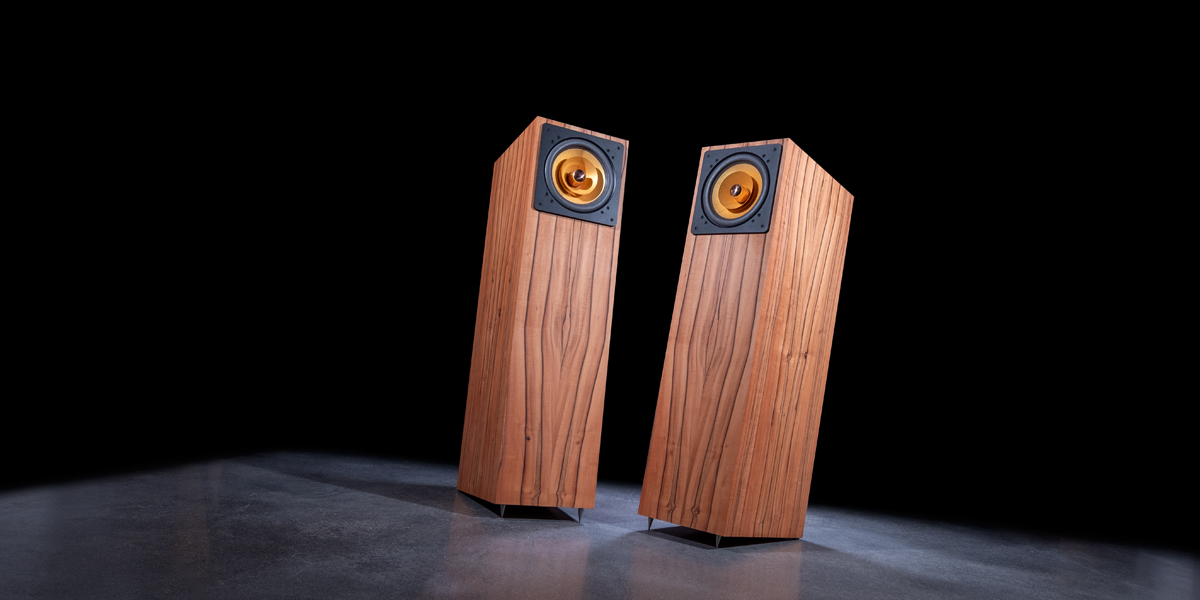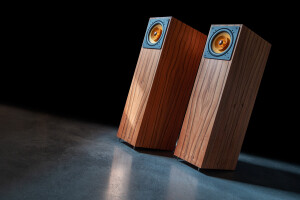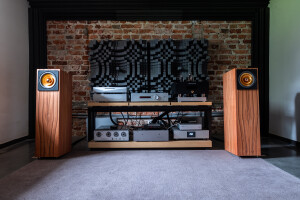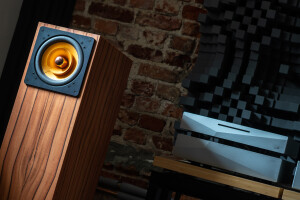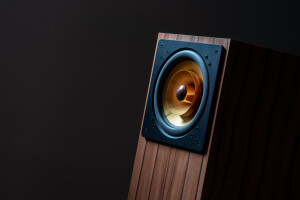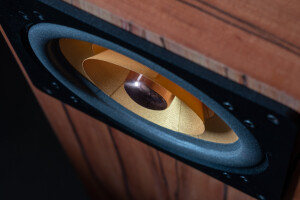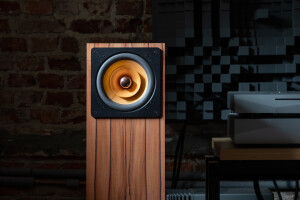Cube Audio Nenuphar reviewed in December 2019 is the very best crossoverless full-range speaker set I’ve heard. Now is the time to find out what its smaller version – Cube Audio Nenuphar Mini – has to offer. Enjoy!
Introduction
Grzegorz Rulka and Marek Kostrzyński are no strangers to this site, and their accomplishments under the local brand Cube Audio are widely known in the industry. Although this roster includes two active twists, purist full-range filterless speakers are its very backbone. This unusual niche breed exists way outside the mainstream audio so is quite the conversation starter all by itself, there aren’t many speaker houses into such products after all. But more importantly, the two Polish engineers mint their own highly unique wideband drivers geared for linearity and extended bandwidth rather than exploded sensitivity. This wise decision led to spectacular results and fully deserved fame, which is just the way how it should be.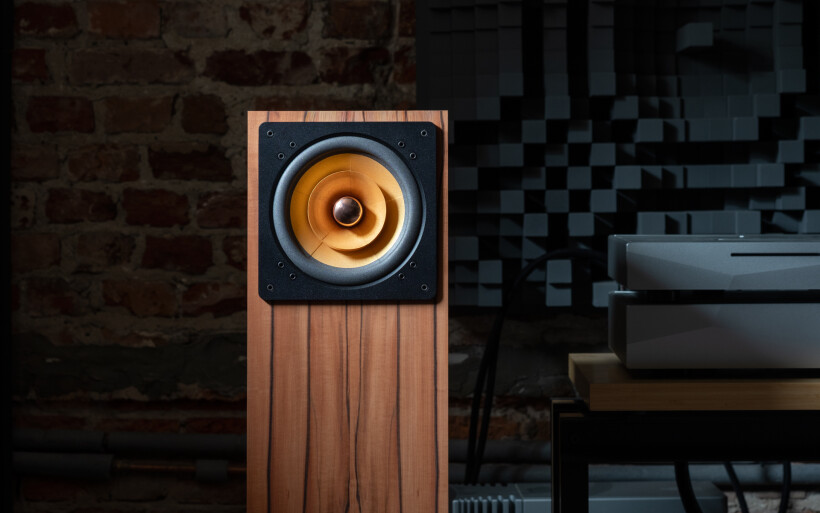 My track record with Cube Audio isn’t extensive, but surely memorable and valuable for me as a full-time reviewer. Prior to this company’s first arrival reviewed here I considered such speakers as finicky affairs aimed at individuals with a rather peculiar taste. The Magus swiftly liberated me from this thinking by its high score on domestication and hardware compliance, and it sounded grand enough to please broad audience. All in all, its inherent full-range sophistication it wrapped into a very accessible package, so in a way stood defiant against its own elitist kind. Although that was quite the mindbender on its own right, the next Cube Audio’s loaner baptized Nenuphar emerged as one of the very best speakers I’ve ever heard. I’ve been thinking about that marvel ever since publishing its review here more than two years ago, and lack of space is the only reason why I haven’t yet pulled the trigger.
My track record with Cube Audio isn’t extensive, but surely memorable and valuable for me as a full-time reviewer. Prior to this company’s first arrival reviewed here I considered such speakers as finicky affairs aimed at individuals with a rather peculiar taste. The Magus swiftly liberated me from this thinking by its high score on domestication and hardware compliance, and it sounded grand enough to please broad audience. All in all, its inherent full-range sophistication it wrapped into a very accessible package, so in a way stood defiant against its own elitist kind. Although that was quite the mindbender on its own right, the next Cube Audio’s loaner baptized Nenuphar emerged as one of the very best speakers I’ve ever heard. I’ve been thinking about that marvel ever since publishing its review here more than two years ago, and lack of space is the only reason why I haven’t yet pulled the trigger.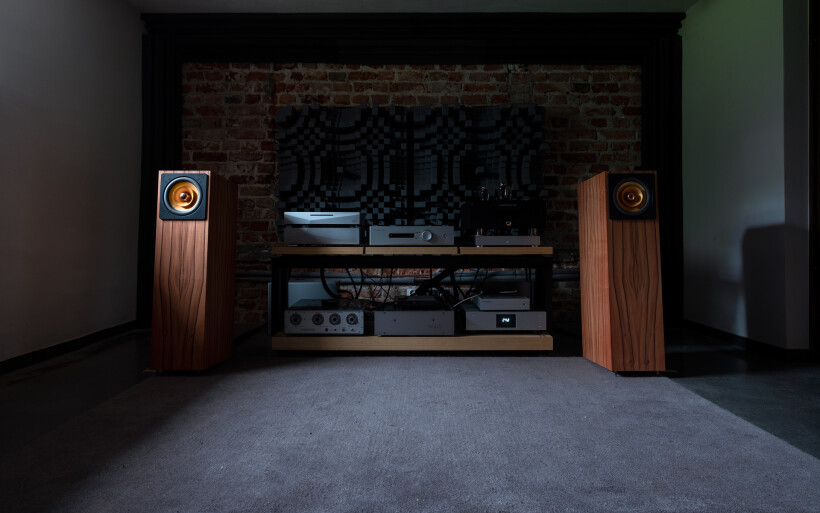 Given my previous exposure to Cube Audio’s developments, I truly looked forward to pretty much anything made by its talented founders. Past covering their two passive efforts I initially thought about detouring towards monitors augmented by active subs, but a more compact Nenuphar version suggested by Grzegorz seemed even more appealing. A lot had happened past its beefier sibling’s departure; my setup’s entire analog end was replaced, the sound|kaos Vox 3afw loaner is still at my disposal, memories about the recently reviewed Camerton Binom-1 are fresh, and my understanding of the full-range sort is a bit better now than it was two springs ago. Having these factors in mind I wondered how Cube Audio Nenuphar Mini would introduce itself; whether would it impress as much as its larger kin, fall short, or perhaps pull something else unexpected?
Given my previous exposure to Cube Audio’s developments, I truly looked forward to pretty much anything made by its talented founders. Past covering their two passive efforts I initially thought about detouring towards monitors augmented by active subs, but a more compact Nenuphar version suggested by Grzegorz seemed even more appealing. A lot had happened past its beefier sibling’s departure; my setup’s entire analog end was replaced, the sound|kaos Vox 3afw loaner is still at my disposal, memories about the recently reviewed Camerton Binom-1 are fresh, and my understanding of the full-range sort is a bit better now than it was two springs ago. Having these factors in mind I wondered how Cube Audio Nenuphar Mini would introduce itself; whether would it impress as much as its larger kin, fall short, or perhaps pull something else unexpected?
Build
Two massive chipboard boxes strapped to a pallet were a 100kg job clearly for two adults. Each coffin put together to easily survive several trips featured steel handles and unpacking guide fixed to its external wall, which made carrying around and extraction of contents fairly convenient and straightforward. Each speaker inside a cloth bag and in-between two thick foam liners had its driver protected via a ply insert. Petite pockets stored several spikes and hex keys to remove these covers and firmly torque transducers afterwards.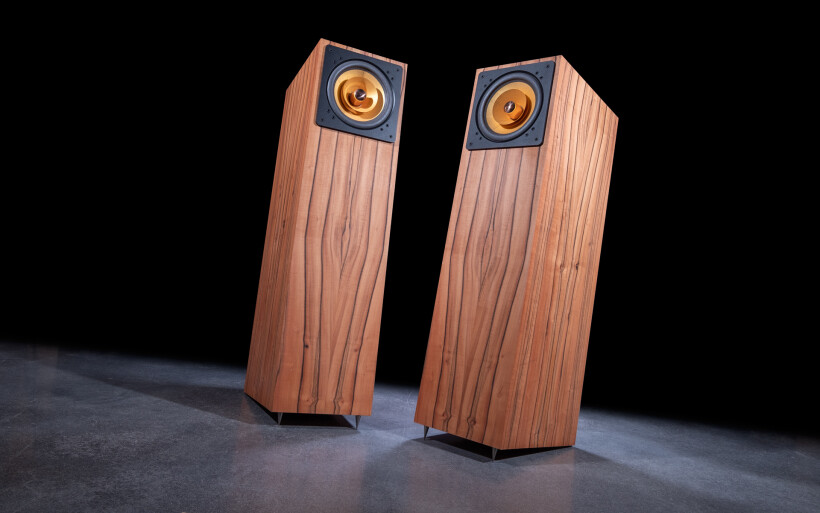 Cube Audio Nenuphar Mini is based on a single 8” full-range driver rear-loaded with a quarter-wave transmission line (aka TQWT) folded inside its enclosure. Its asking price essentially buys you a box with just one transducer directly wired to speaker terminals and that’s it. This minimalist package represents purist topology that works perfectly fine without bass drivers, tweeters, crossovers or anything else. Each Nenuphar Mini measures (WxHxD) 25 x 40 x 100cm and weighs 30kg, so its frame is noticeably lighter, more compact and less capacious versus its larger brother. The former’s impedance is 10Ω, internal volume is 100 liters, FR is 36Hz-18kHz and efficiency of 91dB seals the deal. From these specs we learn that the Mini is easier to drive than the big Nenuphar and doesn’t reach as low. It’s also not crazy on sensitivity in the context of similar products, although that’s on purpose. Grzegorz and Marek cleverly opted for top linearity and bandwidth paid in efficiency, but their Magus already proved us how effective this approach was.
Cube Audio Nenuphar Mini is based on a single 8” full-range driver rear-loaded with a quarter-wave transmission line (aka TQWT) folded inside its enclosure. Its asking price essentially buys you a box with just one transducer directly wired to speaker terminals and that’s it. This minimalist package represents purist topology that works perfectly fine without bass drivers, tweeters, crossovers or anything else. Each Nenuphar Mini measures (WxHxD) 25 x 40 x 100cm and weighs 30kg, so its frame is noticeably lighter, more compact and less capacious versus its larger brother. The former’s impedance is 10Ω, internal volume is 100 liters, FR is 36Hz-18kHz and efficiency of 91dB seals the deal. From these specs we learn that the Mini is easier to drive than the big Nenuphar and doesn’t reach as low. It’s also not crazy on sensitivity in the context of similar products, although that’s on purpose. Grzegorz and Marek cleverly opted for top linearity and bandwidth paid in efficiency, but their Magus already proved us how effective this approach was.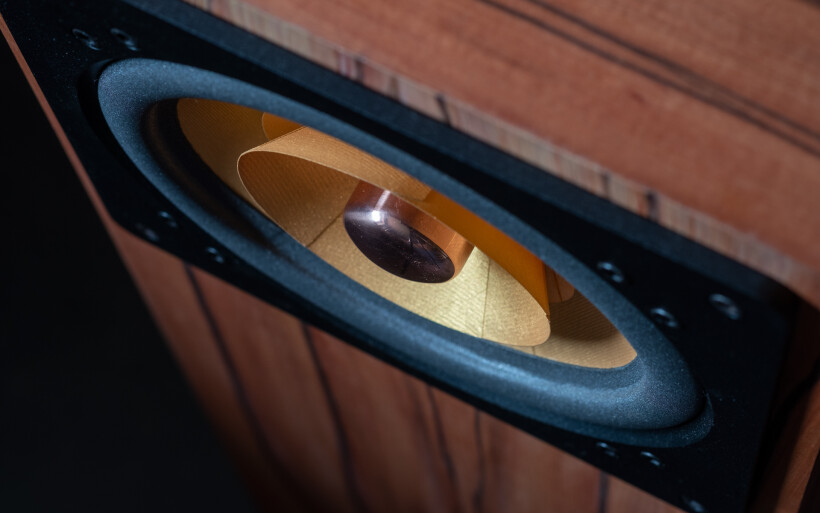 Although the Mini’s cabinets aren’t small by any means, I’ve found them visually quite sleek and less clunky than big Nenuphars, which in my rather small room looked quite intimidating. Each today’s enclosure houses a single 8” transducer on its front, and on the back just above the floor level there’s a nice plate with single WBT nextgen speaker terminals which say nay to bi-wiring. Two of each short rubber hemispheres and spikes underneath each enclosure gently tilt it towards the rear. Its underbelly is the downfiring mouth of an internal transmission route for a driver’s rear strokes. Nenuphar Mini can be ordered glossy or matte in all colors you can think of, and exotic veneers also apply. My loaner dressed in Tineo (Indian apple) was nicely put together and it grew on me in time, but you be the judge whether its monolithic quite regular appeal is to your liking or not.
Although the Mini’s cabinets aren’t small by any means, I’ve found them visually quite sleek and less clunky than big Nenuphars, which in my rather small room looked quite intimidating. Each today’s enclosure houses a single 8” transducer on its front, and on the back just above the floor level there’s a nice plate with single WBT nextgen speaker terminals which say nay to bi-wiring. Two of each short rubber hemispheres and spikes underneath each enclosure gently tilt it towards the rear. Its underbelly is the downfiring mouth of an internal transmission route for a driver’s rear strokes. Nenuphar Mini can be ordered glossy or matte in all colors you can think of, and exotic veneers also apply. My loaner dressed in Tineo (Indian apple) was nicely put together and it grew on me in time, but you be the judge whether its monolithic quite regular appeal is to your liking or not.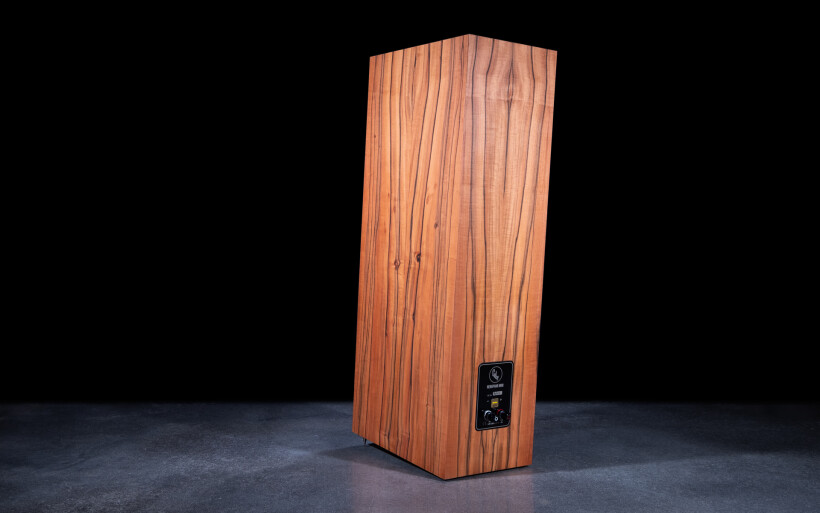 Let’s talk money for a second. Individuals unfamiliar with purist full-range speakers will most likely find today’s single driver inside its regular vanilla-flavored cabinet as a rather insane proposition for its steep asking price. Elsewhere it gets us more cones, sleeker enclosures, fancier finishes etc., but products such as this story’s specimen render anything above what they already feature as unnecessary. In that sense they’re elegantly simple and also promise us performance beyond reach of any other speaker type out there. Here the word ‘simple’ means the exact opposite of ‘easy’, a widebander unit feasible for potent solo acts demands extensive R&D, time and money. Only very few manufacturers pursue this route uphill and Cube Audio’s founders fit that profile. It’s only natural that their blood, sweat and tears don’t come cheap.
Let’s talk money for a second. Individuals unfamiliar with purist full-range speakers will most likely find today’s single driver inside its regular vanilla-flavored cabinet as a rather insane proposition for its steep asking price. Elsewhere it gets us more cones, sleeker enclosures, fancier finishes etc., but products such as this story’s specimen render anything above what they already feature as unnecessary. In that sense they’re elegantly simple and also promise us performance beyond reach of any other speaker type out there. Here the word ‘simple’ means the exact opposite of ‘easy’, a widebander unit feasible for potent solo acts demands extensive R&D, time and money. Only very few manufacturers pursue this route uphill and Cube Audio’s founders fit that profile. It’s only natural that their blood, sweat and tears don’t come cheap.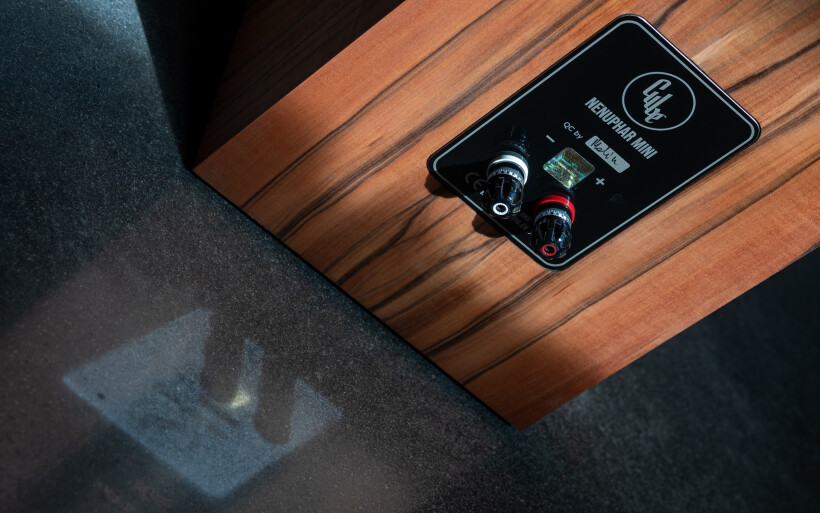 Cube Audio Nenuphar Mini features a driver in the manufacturer’s roster baptized as F8 Neo. The number ‘8’ stands for diameter in inches, whereas the ‘Neo’ bit signifies neodymium not regular ferrite motors. Customers into their own projects can purchase these units for €5’490/pr, mint their own boxes and possibly save quite a pretty penny. I can’t say whether such results would surpass the team Cube’s ready product as described in this story, but it’s good that their business model supports DIY efforts. Moving on, the creation process of a full-range driver requires delicate balancing of its core ingredients. Such transducers usually live inside oddly shaped and sized cabinets to have bass properly developed, but F8 Neo reaches lower than its kind normally does, and requires lesser internal volume to go there. It measures (W x D) 220 x 101mm, weighs 5kg in total and its aluminium basket comprises CNC-milled components screwed together. The motor’s 81 neodymium slugs provide 2.4 Tesla of uniformly dispatched magnetic field along the 9mm tall gap. Then there’s a faraday copper ring and Cube Audio’s signature CNC-milled low-loss ultralinear phenolic spider that absorbs as little acoustic energy as possible. It’s radically different in comparison to usually seen rippled cloth solutions soaked in resin.
Cube Audio Nenuphar Mini features a driver in the manufacturer’s roster baptized as F8 Neo. The number ‘8’ stands for diameter in inches, whereas the ‘Neo’ bit signifies neodymium not regular ferrite motors. Customers into their own projects can purchase these units for €5’490/pr, mint their own boxes and possibly save quite a pretty penny. I can’t say whether such results would surpass the team Cube’s ready product as described in this story, but it’s good that their business model supports DIY efforts. Moving on, the creation process of a full-range driver requires delicate balancing of its core ingredients. Such transducers usually live inside oddly shaped and sized cabinets to have bass properly developed, but F8 Neo reaches lower than its kind normally does, and requires lesser internal volume to go there. It measures (W x D) 220 x 101mm, weighs 5kg in total and its aluminium basket comprises CNC-milled components screwed together. The motor’s 81 neodymium slugs provide 2.4 Tesla of uniformly dispatched magnetic field along the 9mm tall gap. Then there’s a faraday copper ring and Cube Audio’s signature CNC-milled low-loss ultralinear phenolic spider that absorbs as little acoustic energy as possible. It’s radically different in comparison to usually seen rippled cloth solutions soaked in resin.
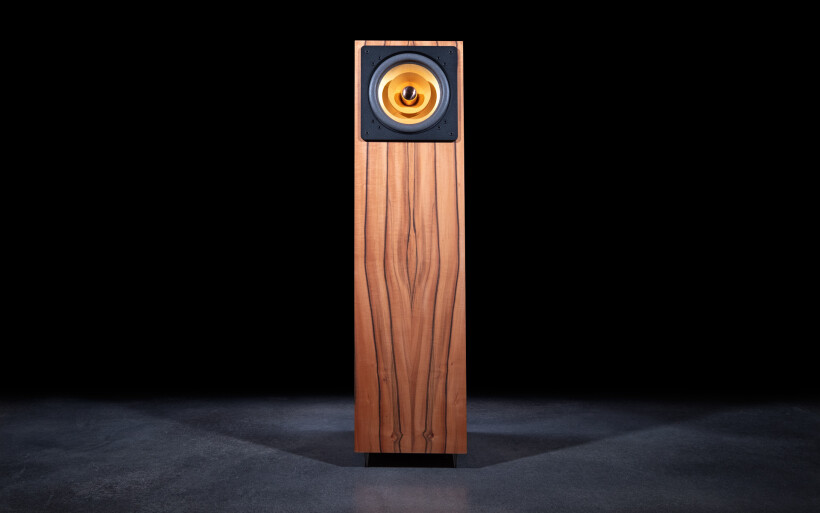 Each F8 Neo’s impregnated paper membrane and upper foam suspension aren’t unusual, but two whizzers for three cones in total surely are, and that’s what gave Grzegorz and Marek the biggest R&D headache. The way how these elements interacted created wiggles in a driver’s frequency response but notch filters to address them were off the table, so mechanical integration with the main membrane was the only way forward. Different geometries, size, shape, coating etc. of involved cones introduced endless possible iterations executed one tiny adjustment, measurement and fix at a time. It’s easy to imagine how huge of a time sink this was, which naturally customers have to see on the final tab.
Each F8 Neo’s impregnated paper membrane and upper foam suspension aren’t unusual, but two whizzers for three cones in total surely are, and that’s what gave Grzegorz and Marek the biggest R&D headache. The way how these elements interacted created wiggles in a driver’s frequency response but notch filters to address them were off the table, so mechanical integration with the main membrane was the only way forward. Different geometries, size, shape, coating etc. of involved cones introduced endless possible iterations executed one tiny adjustment, measurement and fix at a time. It’s easy to imagine how huge of a time sink this was, which naturally customers have to see on the final tab.
Sound
The Innuos Statement handled storage/transport, then a LampizatOr Pacific DAC (KR Audio T-100/Living Voice 300B + KR Audio 5U4G Ltd. Ed.) passed signal to a Trilogy 915R/995R set connected via a Boenicke S3 speaker cable either to sound|kaos Vox 3afw or Cube Audio Nenuphar Mini speakers. Interconnects used were Boenicke Audio IC3 CG and XLRs which I DIY-ed. All key hardware was powered by Boenicke Audio Power Gate distributor box plus its three captive M2 cords and two LessLoss C-MARCs. The USB chain included only one Mercury3.0 USB cable. A set of external LessLoss Firewall for Loudspeakers modules complimented both speaker sets, while a Fidelizer EtherStream was in-between my Linksys WRT160N router and Innuos Statement server. A GigaWatt PC-3 SE EVO+ power conditioner fronted by its own LC-3 EVO cable fed ISOL-8’s Prometheus PSU connected to the router and network switch. Speaker assignments usually start from tackling optimal positioning and suitable companions, but past the previous Nenuphar experience I didn’t have to reinvent the wheel as F8 Neo drivers naturally had alike demands. Their mechanical fondness towards amps of high output impedance was the not so secret sauce. These widebanders simply like to roam free, and the lower an amp’s damping factor for then, the better. Designs without feedback are a bonus. Given these requirements the Bakoon AMP-13R and Kinki Studio EX-M1 had to be off duty. Cube Audio’s 10-incher sounded best with Trilogy’s 925 integrated due to it being a zero feedback design with output impedance high enough to land a DF value of 16 for this load. Unsurprisingly the same maker’s 995R/915R setup was in the ballpark. Its tailoring for the Mini produced sound wholesome enough that I felt no need to engage my FirstWatt F7 fronted by the Thöress DFP.
Speaker assignments usually start from tackling optimal positioning and suitable companions, but past the previous Nenuphar experience I didn’t have to reinvent the wheel as F8 Neo drivers naturally had alike demands. Their mechanical fondness towards amps of high output impedance was the not so secret sauce. These widebanders simply like to roam free, and the lower an amp’s damping factor for then, the better. Designs without feedback are a bonus. Given these requirements the Bakoon AMP-13R and Kinki Studio EX-M1 had to be off duty. Cube Audio’s 10-incher sounded best with Trilogy’s 925 integrated due to it being a zero feedback design with output impedance high enough to land a DF value of 16 for this load. Unsurprisingly the same maker’s 995R/915R setup was in the ballpark. Its tailoring for the Mini produced sound wholesome enough that I felt no need to engage my FirstWatt F7 fronted by the Thöress DFP.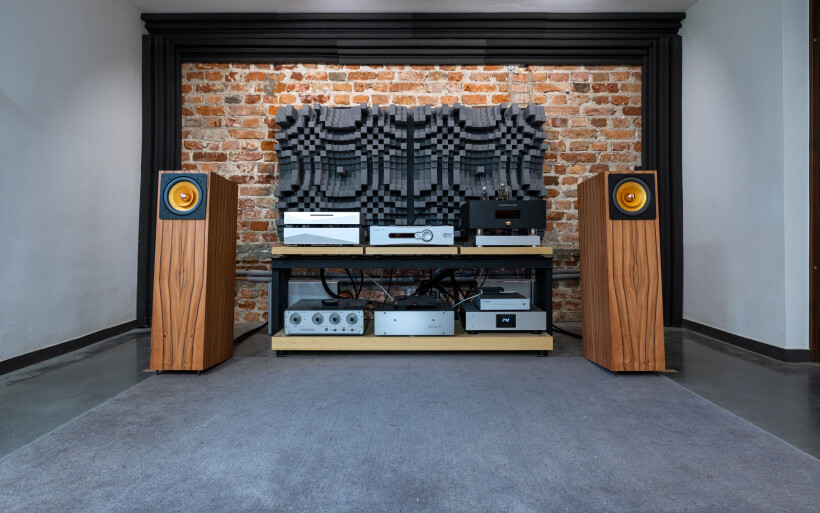 Cube Audio Nenuphar Mini wasn’t fussy about positioning at all. Just a gentle toe in and about a meter to front and side walls was all it took to get it going. I already knew that closing distance to the former surface would reinforce bass and that wasn’t needed. Today’s drivers were also perfectly happy aimed as described. Tilting them towards the inside was counterproductive, which is very unusual considering most such transducers’ beaming directivity. All in all, the Mini didn’t have any special positioning needs to fully come on song. As expected, it scored as high on in-room compliance as its beefier brother.
Cube Audio Nenuphar Mini wasn’t fussy about positioning at all. Just a gentle toe in and about a meter to front and side walls was all it took to get it going. I already knew that closing distance to the former surface would reinforce bass and that wasn’t needed. Today’s drivers were also perfectly happy aimed as described. Tilting them towards the inside was counterproductive, which is very unusual considering most such transducers’ beaming directivity. All in all, the Mini didn’t have any special positioning needs to fully come on song. As expected, it scored as high on in-room compliance as its beefier brother. Although it’s been a while since the 10-inch Cube’s departure, this report’s 8-incher sounded unmistakably alike. Past unboxing and setting it up my attention very quickly drifted from its overall sonic completeness, openness and linearity towards highly entertaining aural performance clearly meant to shock and impress. I remember well how pounding, palpable inside my chest and crazy on bass the first Nenuphar felt. Early on it left me quite puzzled, I simply had no idea that just one unassisted driver could reach this low and be this elastic, powerful and texturally seasoned at once. Although the Mini didn’t go as extremely low, neither it felt hollow, nor limited or in dire assistance of extra subs. It slammed just a hair less wickedly, but easily pulled stunts that would make many regular speakers blush.
Although it’s been a while since the 10-inch Cube’s departure, this report’s 8-incher sounded unmistakably alike. Past unboxing and setting it up my attention very quickly drifted from its overall sonic completeness, openness and linearity towards highly entertaining aural performance clearly meant to shock and impress. I remember well how pounding, palpable inside my chest and crazy on bass the first Nenuphar felt. Early on it left me quite puzzled, I simply had no idea that just one unassisted driver could reach this low and be this elastic, powerful and texturally seasoned at once. Although the Mini didn’t go as extremely low, neither it felt hollow, nor limited or in dire assistance of extra subs. It slammed just a hair less wickedly, but easily pulled stunts that would make many regular speakers blush. Just as its predecessor, the Mini also was clueless how to sound sluggish, bloated, fuzzy or boomy. Not even once it was angry, texturally pale, tense or stiff. It scaled along with SPL increase to develop more and more shove and dynamic might yet remained perfectly clean, pleasantly wet and composed. It had no idea how to shout and pierce, but clearly featured that big-bore open-throated attitude and fearlessness the previous Nenuphar also had. Widebanders are known for directness, immediacy, quickening, clarity, openness, euphony and expressiveness served in a particularly distinct way typical only for them, and the Mini easily covered all these bases. It rendered vocals as distant or intimately close as a given track had them, but they were always pinpoint accurate, internally moist and outlined to feel this much alive. The more years I have under my belt as a full-time reviewer, the more I think that only the full-range kind knows how to portray voices this convincingly.
Just as its predecessor, the Mini also was clueless how to sound sluggish, bloated, fuzzy or boomy. Not even once it was angry, texturally pale, tense or stiff. It scaled along with SPL increase to develop more and more shove and dynamic might yet remained perfectly clean, pleasantly wet and composed. It had no idea how to shout and pierce, but clearly featured that big-bore open-throated attitude and fearlessness the previous Nenuphar also had. Widebanders are known for directness, immediacy, quickening, clarity, openness, euphony and expressiveness served in a particularly distinct way typical only for them, and the Mini easily covered all these bases. It rendered vocals as distant or intimately close as a given track had them, but they were always pinpoint accurate, internally moist and outlined to feel this much alive. The more years I have under my belt as a full-time reviewer, the more I think that only the full-range kind knows how to portray voices this convincingly.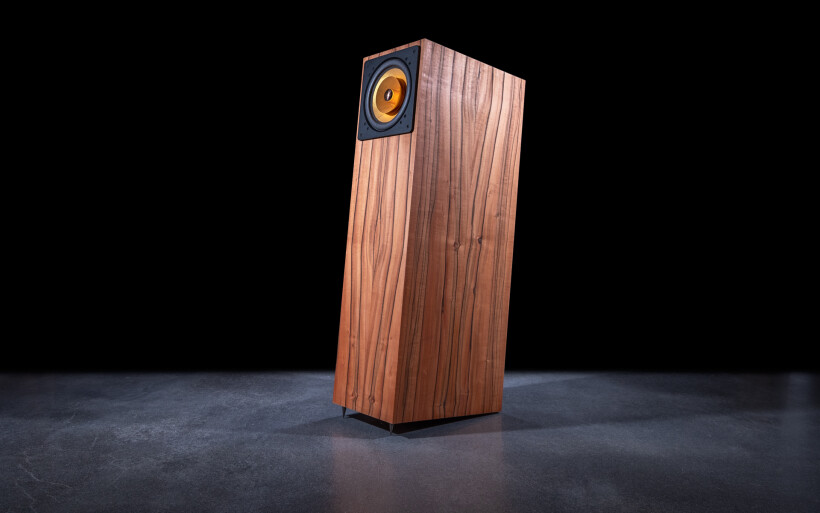 Although the Mini slammed like mad and was sensationally elastic regardless of music type, its bass wasn’t the key focal point but support for bandwidth above. It had measures necessary to rapidly morph from an untamed wildling into a suave creature meant to charm via sensuality. In that sense it knew exactly when, how and in what proportions to blend boldness, agility and speed with euphony, pleasant richness, vividness and organic tissue. As a proper widebander type however the Mini was always direct and insightful, but not even once it felt blunt, crude or forceful. Just as the big Nenuphar before it, this one also struck me as very civilized, tasteful, elegantly mature and not flashy at all.
Although the Mini slammed like mad and was sensationally elastic regardless of music type, its bass wasn’t the key focal point but support for bandwidth above. It had measures necessary to rapidly morph from an untamed wildling into a suave creature meant to charm via sensuality. In that sense it knew exactly when, how and in what proportions to blend boldness, agility and speed with euphony, pleasant richness, vividness and organic tissue. As a proper widebander type however the Mini was always direct and insightful, but not even once it felt blunt, crude or forceful. Just as the big Nenuphar before it, this one also struck me as very civilized, tasteful, elegantly mature and not flashy at all. Due to its inherent quickness, directness and insight, the Nenuphar Mini was free from dilution or veil, and its aural landscapes were admirably coherent, multi-layered, accurate and majestic. Its agile shout-free attitude and willingness to scale with power resulted in sensible effortlessness, propulsion and ability to push a lot of air my way, which in turn naturally expanded dynamic contrasts. The Mini thrived on complex music challenges and not even once felt constricted, compressed or overwhelmed in my room. Given its reasonable frame and overall performance, I think this versatile 8-incher worked marvelously in there, and I haven’t found a single task it wouldn’t pass with flying colors. It’s worth noting that this full-fledged purist widebander affair’s strongly pronounced flavor very intimately, sonorously and explicitly renders instruments and voices. This specific quality typical for the full-range breed is its best asset if someone asks me, quite intoxicating even. Still, you might not like that aroma as some people simply don’t and that’s perfectly fine.
Due to its inherent quickness, directness and insight, the Nenuphar Mini was free from dilution or veil, and its aural landscapes were admirably coherent, multi-layered, accurate and majestic. Its agile shout-free attitude and willingness to scale with power resulted in sensible effortlessness, propulsion and ability to push a lot of air my way, which in turn naturally expanded dynamic contrasts. The Mini thrived on complex music challenges and not even once felt constricted, compressed or overwhelmed in my room. Given its reasonable frame and overall performance, I think this versatile 8-incher worked marvelously in there, and I haven’t found a single task it wouldn’t pass with flying colors. It’s worth noting that this full-fledged purist widebander affair’s strongly pronounced flavor very intimately, sonorously and explicitly renders instruments and voices. This specific quality typical for the full-range breed is its best asset if someone asks me, quite intoxicating even. Still, you might not like that aroma as some people simply don’t and that’s perfectly fine.
Summary
Cube Audio Nenuphar effectively raised the bar for pretty much every other speaker set that came after it, and is one of the finest such products I’ve came across regardless of price and type. Grzegorz and Marek had mastered the fine arts of downscaling it seems, their Nenuphar Mini is very much alike where it matters most.
At first glance Cube Audio Nenuphar Mini might seem very steeply priced given its plain dress code and overall feel, but it doesn’t need anything above just one posh driver per box to do what it does. Its high in-room compliance, rather compact frame and stout sonics spell out extensive R&D and cleverness the final tab has to cover. Assembly on the Polish soil, in-house machining and business model based on a regular distribution network also factor in. Today’s elegantly simple marvel works fabulously without any auxiliary means, and is enjoyably accessible to please audience far wider than just enthusiasts of the purist full-range breed. These two assets alone are worth a lot.
Previous Cube Audio’s products proved me well how domesticated, free from the usual downsides and performance wise spectacular their specialist kind can be. This story’s Nenuphar Mini is no less bonkers on these fronts. If it had arrived before its heftier brother, it would’ve received the red award instead, that’s how good it is. ‘Til next time!
Associated Equipment:
- Amplifier: Trilogy 995R
- DAC: LampizatOr Pacific (KR Audio T-100 / Living Voice 300B + KR Audio 5U4G Ltd. Ed.)
- Speakers: sound|kaos Vox 3afw
- Transport: Innuos Statement
- Preamplifier: Trilogy 915R
- Speaker cables: Boenicke Audio S3, LessLoss C-MARC
- Speaker signal conditioning: LessLoss Firewall for Loudspeakers
- Interconnects: Boenicke Audio IC3 CG
- Power components: Gigawatt PC-3 SE EVO+/LC-3 EVO, LessLoss C-MARC, Boenicke Audio Power Gate, ISOL-8 Prometheus
- USB components: iFi audio Mercury3.0
- Rack: Franc Audio Accesories Wood Block Rack
- Network: Fidelizer EtherStream, Linksys WRT160N
- Music: NativeDSD
Retail prices of reviewed components in EU (incl. tax):
- Cube Audio Nenuphar Mini: €12’900/pr
Manufacturer: Cube Audio


